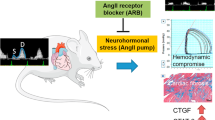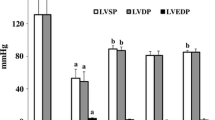Summary
Chronic, pathophysiological elevations of angiotensin (Ang) II cause myocyte necrosis and coronary vascular damage. These adverse effects are mediated by the angiotensin II type 1 (AT1) receptor and are, therefore, preventable with AT1 receptor blockade. Additionally, the intracellular signaling cascade stimulated by elevations in Ang II results in an AT1 receptor-mediated catecholamine release, and the myocardial damage can also be attenuated by β1-adrenergic receptor blockade. The restriction of myocardial damage to the first 3 days of Ang II infusion is due to subsequent downregulation of the β1-adrenergic receptor population. Discontinuation of the Ang II infusion results in a return to normal β1-adrenergic receptor density, which makes the myocardium susceptible once again to subsequent elevations of Ang II. This Ang II-related myocardial damage could play an important role in the pathogenesis of heart failure post-myocardial infarction or in other cardiac disease states.
Access this chapter
Tax calculation will be finalised at checkout
Purchases are for personal use only
Preview
Unable to display preview. Download preview PDF.
Similar content being viewed by others
References
Gavras H, Kremer D, Brown JJ, Gray B, Lever AF, MacAdam RF, Medina A, Morton JJ, Robertson JIS. 1975. Angiotensin-and norepinephrine-induced myocardial lesions: Experimental and clinical studies in rabbits and man. Am Heart J 89:321–332.
Gavras H, Brown JJ, Lever AF, MacAdam RF, Robertson JIS. 1971. Acute renal failure, tubular necrosis, and myocardial infarction induced in the rabbit by intravenous angiotensin II. Lancet 2:19–22.
Tan LB, Jalil JE, Pick R, Janicki JS, Weber KT. 1991. Cardiac myocyte necrosis induced by angiotensin II. Circ Res 69:1185–1195.
Staroukine M, Devriendt J, Decoodt P, Verniory A. 1984. Relationship between plasma epinephrine, norepinephrine, dopamine, and angiotensin II concentrations, renin activity, hemodynamic state and prognosis in acute heart failure. ACTA Cardiol 39:131–138.
Kuroda T, Shida H. 1983. Angiotensin II induced myocardial damage with a special reference to low cardiac output syndrome. Jpn Heart J 24:235–243.
Kabour A, Henegar JR, Janicki JS. 1994. Angiotensin II (AII)-induced myocyte necrosis: Role of the All receptor. J Cardiovasc Pharmacol 23:547–553.
Rodrigues MAM, Bregagnollo EA, Montenegro MR, Tucci PJF. 1992. Coronary vascular and myocardial lesions due to experimental constriction of the abdominal aorta. International J Cardiol 35:253–257.
Cowan MJ, Giddens WE, Reichenbach DD. 1983. Selective myocardial cell necrosis in non-human primates. Arch Pathol Lab Med 107:34–39.
Giacomelli F, Anversa P, Wiener J. 1976. Effect of angiotensin-induced hypertension on rat coronary arteries and myocardium. Am J Pathol 84:111–138.
Bhan RD, Giacomelli F, Wiener J. 1978. Ultrastructure of coronary arteries and myocardium in experimental hypertension. Exp Mol Pathol 29:66–81.
Bhan RD, Giacomelli F, Wiener J. 1982. Adrenoreceptor blockade in angiotensin-induced hypertension. Am J Pathol 108:60–71.
Kabour A, Henegar JR, Devineni VR, Janicki JS. 1995. Prevention of angiotensin II induced myocyte necrosis and coronary vascular damage by lisinopril and losartan in the rat. Cardiovasc Res 29:543–548.
Reddy HK, Campbell SE, Janicki JS, Zhou G, Weber KT. 1993. Coronary microvascular fluid flux and permeability: Influence of angiotensin II, aldosterone, and acute arterial hypertension. J Lab Clin Med 121:510–521.
Laine GA, Allen SJ. 1996. Left ventricular myocardial edema: Lymph flow, interstitial fibrosis and cardiac function. Circ Res 68:1713–1721.
Jalil JE, Janicki JS, Pick R, Abrahams C, Weber KT. 1989. Fibrosis-induced reduction of endomyocardium in the rat after isoproterenol treatment. Circ Res 65:258–264.
Brilla CG, Janicki JS, Weber KT. 1991. Impaired diastolic function and coronary reserve in genetic hypertension. Circ Res 69:107–115.
Lefroy DC, Wharton J, Crake T, Knock GA, Rutherford RAD, Suzuki T, Morgan K, Polak JM, Poole-Wilson PA. 1996. Regional changes in angiotensin II receptor density after experimental myocardial infarction. J Mol Cell Cardiol 28:429–440.
Allen IS, Cohen NM, Gaa ST, Lederer WJ, Rogers TB. 1988. Angiotensin II increases spontaneous contractile frequency and stimulates calcium current in cultured neonatal rat heart myocytes: Insights into the underlying biochemical mechanisms. Circ Res 62:524–534.
Bishop SP, Meisen LR. 1976. Myocardial necrosis, fibrosis, and DNA synthesis in experimental cardiac hypertrophy induced by sudden pressure overload. Circ Res 39:238–245.
Henegar JR, Brower GL, Kabour A, Janicki JS. 1995. Catecholamine response to chronic ANG II infusion and its role in myocyte and coronary vascular damage. Am J Physiol 269:H1564–H1569.
Campbell SE, Brilla CG, Weber KT. 1994. Myocardial fibrosis: Structural basis for pathological remodeling and the role of the renin-angiotensin-aldosterone system. In The cardiac-renin-angiotensin system. Ed. K Lindpainter and D Ganten, 153–165. Armonk, NY: Futura Publishing.
Benjamin IJ, Jalil JE, Tan LB, Cho K, Weber KT, Clark WA. 1989. Isoproterenol-induced myocardial fibrosis in relation to myocyte necrosis. Circ Res 65:657–670.
Van Vliet PD, Burghell HB, Titus JL. 1966. Focal myocarditis associated with pheochromocytoma. New Eng J Med 274:1102–1108.
Mann DL, Kent RL, Parsons B, Cooper G. 1992. Adrenergic effects on the biology of the adult mammalian cardiocyte. Circulation 85:790–804.
Speth RC, Khosla MC, Spech MM, Ferrario CM. 1981. Rat (Ile5) but not bovine (Val5) angiotensin raises plasma norepinephrine in rats. Hypertension 3:II-25-II-29.
Pilati CF, Bosso FJ, Maron MB. 1992. Factors involved in left ventricular dysfunction after massive sympathetic activation. Am J Physiol 263:H784–H791.
Kawabata M. 1970. The actions of synthetic angiotensin II on adrenal and myocardial catechola-mines. Jap Circ J 34:587–593.
Cline WH. 1971. Release of catecholamines during the induction of and recovery from tachyphylaxis to angiotensin II. J Pharmacol Exp Ther 179:532–542.
Henegar JR, Janicki JS. 1996. Sympathetic neuron norepinephrine is responsible for angiotensin II-induced myocardial damage, (abstract) Circulation 94:1659.
Ratajska A, Campbell SE, Sun Y, Weber KT. 1994. Angiotensin II associated cardiac myocyte necrosis: Role of adrenal catecholamines. Cardiovasc Res 28:684–690.
Eisenhofer G, Friberg P, Rundqvist B, Quyyumi AA, Lambert G, Kaye DM, Kopin IJ, Goldstein DS, Esler MD. 1996. Cardiac sympathetic nerve function in congestive heart failure. Circulation 93:1667–1676.
Jones CR, Molenar P, Summers RJ. 1989. New views of human cardiac β-adrenoceptors. J Mol Cell Cardiol 21:519–535.
Murphree SS, Saffitz JE. 1987. Quantitative autoradiography delineation of the distribution of adrenergic receptors in canine and feline left ventricular myocardium. Circ Res 60:568–579.
Tan LB, Benjamin IJ, Clark WA. 1992. β adrenergic receptor desensitisation may serve a cardioprotective role. Cardiovasc Res 26:608–614.
Henegar JR, Janicki JS. 1996. Downregulation of the beta adrenergic receptors during chronic angiotensin II infusion, (abstract) Circulation 94:1672.
Page DL, Caulfield JB, Kastor JA, DeSanctis RW, Sanders CA. 1971. Myocardial changes associated with cardiogenic shock. New Eng J Med 285:133–137.
Corday E, Kaplan L, Meerbaum S, Brasch J, Constantini C, Lang TW, Gold H, Rubins S, Osher J. 1975. Consequences of coronary arterial occlusion on remote myocardium: Effects of occlusion and reperfusion. Am J Cardiol 36:385–394.
Beltrami CA, Finato N, Rocco M, Feruglio GA, Puricelli C, Cigola E, Quaini F, Sonnenblick EH, Olivetti G, Anversa P. 1994. Structural basis of end-stage failure in ischemic cardiomyopathy in humans. Circulation 89:151–163.
Kabour A, Henegar JR, Janicki JS. 1993. Angiotensin converting enzyme inhibition attenuates myocyte necrosis remote to myocardial infarction, (abstract) Clin Res 41:658A.
Pfeffer MA, Pfeffer JM, Steinberg C, Finn P. 1985. Survival after an experimental myocardial infarction: Beneficial effects of long-term therapy with captopril. Circulation 72:406–412.
The CONCENSUS Trial Study Group. 1987. Effects of enalapril on mortality in severe congestive heart failure: Results of the Cooperative North Scandinavian Enalapril Survival Study (CONSENSUS). New Engl J Med 316:1429–1437.
Author information
Authors and Affiliations
Editor information
Editors and Affiliations
Rights and permissions
Copyright information
© 1998 Springer Science+Business Media New York
About this chapter
Cite this chapter
Henegar, J.R., Brower, G.L., Janicki, J.S. (1998). Characteristics and Mechanisms of Angiotensin II-Related Myocardial Damage. In: Dhalla, N.S., Zahradka, P., Dixon, I.M.C., Beamish, R.E. (eds) Angiotensin II Receptor Blockade Physiological and Clinical Implications. Progress in Experimental Cardiology, vol 2. Springer, Boston, MA. https://doi.org/10.1007/978-1-4615-5743-2_37
Download citation
DOI: https://doi.org/10.1007/978-1-4615-5743-2_37
Publisher Name: Springer, Boston, MA
Print ISBN: 978-1-4613-7631-6
Online ISBN: 978-1-4615-5743-2
eBook Packages: Springer Book Archive




